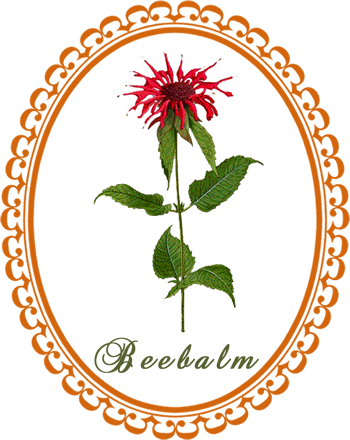
Bee Balm: as the name suggests, this plant is much-loved by bees and is often grown near their hives. The leaves keep their fragrance for a long time, and can be used in potpourris or sachets ...
Common Names: Bee Balm, Bergamot, Oswego tea
Botanical Name: Monarda didyma
Family: Lamiaceae
Plant Type: Perennial, Biennial or Annual, depending on variety.
Parts Used: Leaves
Flowering: June to July
Bee Balm is a perennial herb native to Eastern North America. It grows in dry thickets, clearings and woodland edges from Ontario and British Columbia to Georgia and Mexico.
Description: Bee Balm has showy, red, pink, or lilac flowers in large heads or whorls of about 20-50 flowers at the top of the branching stem, supported by leafy bracts, the leaflets are a pale-green color. The stem of Bee Balm is square, grooved and hard; and about 3 feet high. The leaves occur in opposite pairs, are rough on both surfaces, are distinctly toothed, and lance-shaped. Fine dense hairs cover much of the stem and leaves. Bee Balm roots are short, slender, creeping rhizomes.
Cultivation: Bee Balm is easily grown in ordinary garden soil. It also grows well in heavy clay soils, requires a part shade to sunny place to grow. This species thrives when grown in a dry soil and prefers alkaline soil conditions. Bee Balm multiplies prolifically by sending out runners, which can be transplanted to increase plant numbers, but will grow from seed as well. It is hardy to zone 4.
Harvesting: Pick the leaves just before flowering.
Culinary Uses: Monarda has a sweet citrus flavor. Use the leaves in salads, fruit dishes, curries, sausages, and teas.
Native American Herb Wisdom
The name Oswego Tea comes from the Oswego Indians who taught the immigrants how to use it for tea after the Boston tea party in 1773. Bee Balm has a long history of use as a medicinal plant by many Native Americans including the Blackfeet. The Blackfeet Indians recognized this plant's strong antiseptic action, and used poultices of the plant for skin infections and minor wounds. A tea made from the plant was also used to treat mouth and throat infections caused by dental caries and gingivitis. Bee Balm is the natural source of the antiseptic Thymol, the primary active ingredient in modern commercial mouthwash formulas. The Winnebago used a tea made from bee Balm as a general stimulant. Bee Balm was also used as a carminative herb by Native Americans to treat excessive flatulence. Source: wiki
Herbal Healing with Bee Balm
Medicinal Actions: Antithelmintic, antibacterial, antifungal, antiseptic, antispasmodic, antiviral, carminative, diuretic, expectorant, stimulant, tonic, vermifuge
Medicinal Uses: Use an infusion of monarda leaves for coughs, sore throat, nausea, and menstrual cramps. The oil contains thymol which is antibacterial, antifungal, and vermifuge. A tea made from the flowering heads and leaves can be used to induce sweating to break fevers and encourage restful sleep.
Bee Balm Tea: To 1 tsp. dried herb, add 1 cup boiling water, steep 10 min. Sweeten to taste, take at bedtime.
If you appreciate the information provided,
please help keep this website running. Blessings!
© 2008-2025 aromaworx.ca. All rights reserved.

